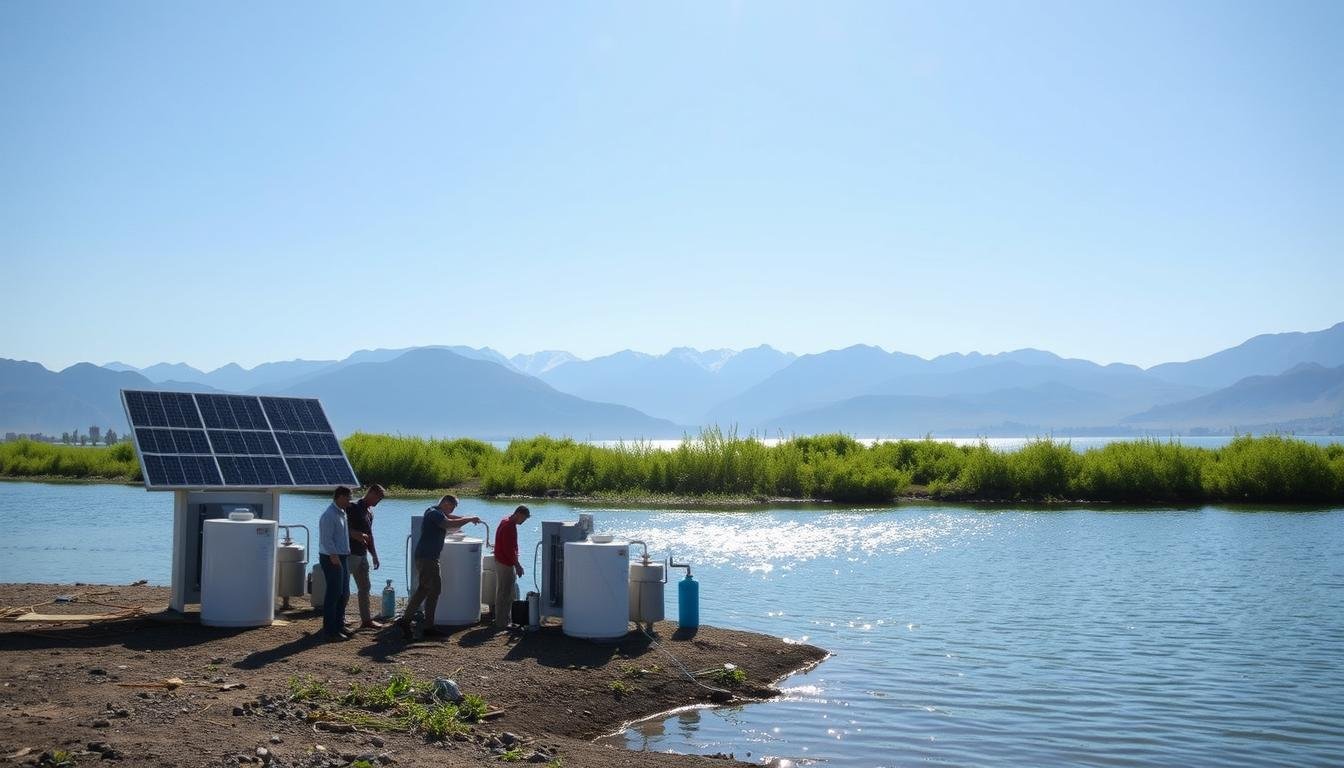Air travel pollutes the environment a lot. The aviation industry is responsible for 2.8% of global greenhouse gas emissions. We need cleaner ways to fly.
There are three ways to make air travel greener: using sustainable aviation fuels, designing new engines, and exploring new propulsion systems. These methods can reduce emissions and make flying better for the planet.
The Importance of Air Sustainability
Air sustainability is key for our health and the environment. High emissions from vehicles harm people’s health in cities. Clean technologies like hydrogen fuel and sustainable aviation fuel can greatly reduce emissions.
The aviation industry is working hard to cut emissions. They’re using new designs and recycling carbon. These steps help reduce the carbon footprint and support flying without harming the environment.
Planting green spaces and using filters can improve air quality. Working together, governments, businesses, and nonprofits can make a big difference. They can encourage using electric buses and bikes, which are better for the planet.
This teamwork helps cities fight climate change and improve life quality. Everyone’s efforts make our health and environment better.
3 Air Sustainable Solutions for Urban Areas
1. Urban Green Spaces
Green spaces in cities clean the air by absorbing pollutants. Trees and plants act as natural filters, reducing emissions. They help fight air pollution and support climate action.
These areas also offer places for people to relax and enjoy nature. They encourage walking or cycling, which reduces vehicle use and emissions. Using native plants in these spaces saves water and energy.
Organizations like the Solar Impulse Foundation support green spaces. They show how these areas can be profitable and help the environment. They also improve flight efficiency and community health.
2. Energy-Efficient Public Transportation
Cities can make public transport cleaner with new technologies. Electric buses and hydrogen fuel vehicles cut emissions. Using sustainable aviation fuel in flights can inspire similar changes in public transport.
Filtration machines at bus stops can clean the air. This shows a commitment to environmental health. Clean technologies, like open fan architecture in aviation, offer solutions for public transport.
Engaging locals with incentives can make them choose sustainable transit. This can lead to a healthier environment and lower emissions. By supporting green spaces and clean technologies, cities can tackle environmental challenges and improve health.
3. Smart Air Quality Management Systems
Smart Air Quality Management Systems in cities use technology to monitor and cut down on pollutants. They install machines to clean the air, reducing harmful emissions from vehicles and construction. These systems also track air quality, helping with climate action and ecological changes.
These systems use clean technologies like sustainable aviation fuel and hydrogen. They help manage emissions and lower carbon footprints. This makes the air healthier, which is good for public health and fighting climate change. For example, businesses and nonprofits can get incentives for using pollution control methods.
Cities can also use these systems to plan better. They can create more green spaces and look into new ideas, like open fan architecture for planes. This ensures flights are efficient and don’t harm the environment, promoting sustainable travel.
3 Air Sustainable Solutions for Rural Communities
1. Sustainable Agriculture Practices
Sustainable farming keeps the environment healthy and supports biodiversity. It uses methods that cut down greenhouse gas emissions. For example, crop rotation prevents soil loss and reduces the need for chemical fertilizers.
Supporting farmers who use sustainable methods helps food security and public health. Green spaces in cities also help by absorbing carbon dioxide and improving air quality. By backing clean technologies, communities can encourage low-carbon solutions.
California has offered incentives for sustainable aviation fuels. This shows the benefits of using clean energy like hydrogen fuel and efficient travel. Every community can help lower emissions and fight climate change.
2. Renewable Energy Solutions
New renewable energy options are being explored, like sustainable aviation fuels and hydrogen. The aviation industry is turning to these efficient solutions to cut emissions and carbon footprint.
Sustainable aviation fuel, made from waste, can greatly reduce carbon dioxide emissions. Using these renewable solutions supports climate action by cutting emissions and improving air quality in cities.
Electric vehicles and clean technologies in urban planning also help. They reduce tailpipe emissions and pollutants. This improves public health and creates jobs in rural areas. By adopting clean technologies, communities can grow economically while protecting the environment.
3. Air Quality Monitoring Networks
Air quality monitoring networks measure pollutants in rural areas. They provide data for improving air quality, supporting climate action, and urban planning. In California, they track emissions and offer incentives for cleaner technologies.
These networks work with smart air quality systems to improve data accuracy. This helps cities implement solutions like filtration machines and sustainable transit options. But, collecting and reporting data can be hard in remote areas with limited resources.
Keeping up with monitoring is tough due to funding and personnel issues. But, innovations like open fan architecture and carbon recycling can help. They drive towards net-zero emissions and cleaner air for all.
3 Air Sustainable Solutions in Travel and Tourism
1. Eco-Friendly Travel Packages
Eco-friendly travel packages use sustainable aviation fuel to cut down carbon emissions. They also highlight advanced aircraft designs for better air quality. These packages offer green transport options like buses or electric vehicles.
They support local businesses that use low-carbon solutions. This helps the economy and fights climate change. Activities like cycling or using spinning bikes also reduce tourism’s carbon footprint.
These packages encourage travelers to choose environmentally friendly options. This helps address issues like climate change and air pollution.
2. Carbon Offsetting Programs
Good carbon offsetting programs support sustainable aviation fuel and clean technologies. They help balance flight emissions with carbon removal projects. This makes the aviation industry more eco-friendly.
Look for programs that invest in energy efficiency and renewable energy. For example, the Solar Impulse Foundation supports such projects. These programs help reduce air pollution and improve air quality.
Efficient solutions like hydrogen fuel vehicles and advanced aircraft designs are also supported. By joining these programs, travelers help the environment. They support businesses and nonprofits working on climate action.
3. Sustainable Accommodation Practices
Sustainable accommodations use clean technologies to reduce their environmental impact. They often use solar panels and energy-efficient systems. They also support the aviation industry’s goal for net-zero emissions.
These accommodations promote green spaces and low-carbon solutions. They tackle environmental challenges like climate change and air pollution. They also support local economies by working with businesses and nonprofits.
Guests are encouraged to use bicycles or spinning bikes for transport. This reduces their carbon footprint. They also learn about carbon recycling and hydrogen fuel, improving public health and the environment.
Future Outlook for Air Sustainability
New technologies and practices will emerge soon. Sustainable aviation fuels will significantly reduce emissions. The aviation industry aims for net-zero emissions with efficient solutions.
Clean technologies like air filtration machines will manage pollutants in cities. Green spaces will improve air quality and public health. Policy changes and collaboration will promote low-carbon solutions.
Initiatives like the Solar Impulse Foundation show carbon-neutral actions are possible. As awareness grows, more people will choose sustainable transport options. This will reduce emissions and carbon footprints.
Educational efforts will be key to address environmental challenges. They will foster a culture of climate action. This will help reduce greenhouse gas emissions and improve air quality for healthier living spaces.
Collaborative Efforts and Policy Changes
Stakeholders can work together to make air cleaner by sharing knowledge and resources. This includes clean technologies.
The aviation industry wants to be carbon neutral by 2050. They’re using sustainable fuels and new designs to cut emissions. Cities are also helping by promoting cleaner transport like buses and hydrogen cars.
By working together, we can make a big difference. For example, using machines to clean the air and planting green spaces helps a lot. Public-private partnerships fund projects that help the environment, like recycling carbon in California.
These efforts help us move towards a greener future. They tackle climate change and make cities and flying better for everyone.
FAQ
What are the three air sustainable solutions that can contribute to a greener future?
- Invest in electric buses and trains for better public transport.
- Create bike lanes and paths to encourage biking and walking.
- Use solar power for heating and cooling buildings.
How do these air sustainable solutions improve air quality?
These solutions cut down on pollutants. They use air purifiers, clean energy, and plants to clean the air. For example, electric vehicles and green roofs help a lot.
What role do renewable energy sources play in these sustainable air solutions?
Renewable energy powers electric aircraft and other green solutions. Solar panels at airports are a great example. They cut down on fossil fuel use and emissions.
Can individuals implement these air sustainable solutions in their daily lives?
Yes, you can make a difference by using less energy and choosing cleaner transport. Planting trees and recycling also helps. Using air purifiers and low-VOC products improves indoor air.
What are the long-term benefits of adopting air sustainable solutions for the environment?
These solutions cut down on emissions and improve air quality. They make us healthier and save money in the long run. Switching to electric vehicles and better public transport are good examples.







